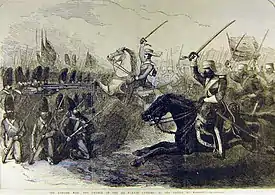Battle of Khushab
The Battle of Khushab (Persian: جنگ خوشاب) took place on 7 February 1857 and was the largest single engagement of the Anglo-Persian War. Having taken Borazjan without a fight, the British expeditionary army under Sir James Outram was in the process of withdrawing to Bushehr when it was ambushed by a far larger Persian force under Khanlar Mirza, drawn up in battle order to its rear. The battle ended with Persian victory and the withdrawal of British troops from Ahvaz, Iran.
| Battle of Khushab | |||||||
|---|---|---|---|---|---|---|---|
| Part of Anglo-Persian War | |||||||
 British-Indian forces attacking at the Battle of Khushab | |||||||
| |||||||
| Belligerents | |||||||
| United Kingdom | Persia | ||||||
| Commanders and leaders | |||||||
| Major General Sir James Outram | Khanlar Mirza | ||||||
| Strength | |||||||
| 4600 total, including 2200 British infantry, 2000 Indian infantry, 400 cavalry, and 18 guns. [1] | 2500 [2] | ||||||
| Casualties and losses | |||||||
| 220 dead, 64 wounded [3] | 50 dead, 100 prisoners [4] | ||||||
The distinguishing action of the battle was the charge of the 3rd Bombay Light Cavalry (now amalgamated into The Poona Horse) against an infantry square of the 1st Khusgai Regiment of Fars, in which two Victoria Crosses were won. The recipients were the commander's adjutant Lieutenant Arthur Thomas Moore, who first broke into the square, and Captain John Grant Malcolmson, who then extricated Moore. Only twenty of the five hundred soldiers in the square escaped. Having beaten off the ambush, the British continued their withdrawal to Bushehr.
References
- "The End of the Anglo-Persian War" Published in History Today Volume 57 Issue 3 March 2007
- "The End of the Anglo-Persian War" Published in History Today Volume 57 Issue 3 March 2007
- "The End of the Anglo-Persian War" Published in History Today Volume 57 Issue 3 March 2007
- "The End of the Anglo-Persian War" Published in History Today Volume 57 Issue 3 March 2007